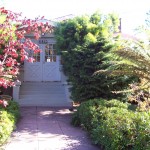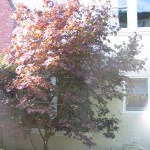
Our old Buckeye tree

One of the smaller Japanese maples,bordering the pathway up to the house.
One of the first things I noticed when returning to my house after a year away were the unusually bare branches on a large Japanese maple tree in the front yard. On further inspection, it looked like the leaves were all wilted. Later, I discovered that the other slightly smaller maple was also showing signs of stress. A third maple tree, small and unique because its produces delicate pink leaves instead of red, also seemed to be losing it leaves unusually early.
I knew right away something was wrong with the big maple. I found myself in a state of mourning for this tree, which a previous owner had planted and we had watched grow into a big and showy drama, almost self-conscious in its prime placement and bright red leaves. At one point we had considered adding a garage next to the house near this tree but I balked when I got the price quote–and when I learned I would have to take out this maple tree to create access to the garage.
I asked different people what could have happened with this tree and the others. Some thought maybe they had gotten too much water. Another friend thought they might have a disease common to maple trees and spread the disease to each other through their root system. Finally, I called a plant pathologist, thinking that if they had a disease, it might be reversible. A woman showed up one morning with a spade and small saw in one hand and a bag for collecting the samples in another. She sawed off part of the trunk of each tree and took it back to her laboratory. She conjectured, however, that the maples were simply stressed. They had been planted in sunny locations and couldn’t tolerate the sun after so many years. A few weeks later I received a letter telling me that no disease had been detected and giving me a list of possible replacement trees better suited those locations.
Maybe it’s no surprise that even trees can get stressed, just like humans, if not supplied with the right environment and food and water. During the plant pathologist’s visit, I had walked her around the yard and showed her with pride the bumpy old Buckeye tree in the backyard. It looks to be 100 years old. She said it was likely a true native California variety and looked to be in good shape. If that tree ever dies, it will be a tragedy. It is huge with big knobby protrusions that look like elbows and knees. In May it unfurls beautiful big white flowers and through the summer and fall it sheds balls like acorns. I was very happy to hear that this tree is a native. I wondered if the tree had been planted by some previous owner or it just sprung up there itself and I pictured it alone and happy on an empty rolling hillside before all the houses and yards came and surrounded it.
I also showed the pathologist one more tree, and this one I was most curious about. It is the Dutch Elm tree that borders the street. When we moved into our house 14 years ago, the street was lined on each side with old Dutch Elms, which grow in a spreading manner, so that their top branches create a canopy. The street was lovely and even well-known in the neighborhood for its Elms. However, one by one, the trees succumbed to Dutch Elm disease. Each year city inspectors would draw a big red X on a dead tree and a few months later come and remove it. The sound of chainsaws was like a death call and the sight of one branch after another falling to the ground was almost too sad to watch. Fortunately, the city had money in their budget to replace the trees with Sycamores, more hardy street trees, but not nearly as lovely as they grow vertically and don’t create a canopy.
Somehow, our Dutch Elm and a few others have survived all this. There were a few years when our tree looked pretty bad. Very few branches leafed out. The branches were so bare of greenery the most prominent sign of life were huge birds’ nests perched in the Vs of the empty branches. This year however, our tree looks the best I’ve seen it in a long time. I asked the pathologist why. She surmised that it could be the fact that our sprinkler system supplies a small bit of water to that portion of the sidewalk. Or perhaps it is because most of the other Elms are gone and it is no longer threatened by diseased trees. It’s true that both our neighbors lost their trees early on; maybe that helped ours survive. Then again, it may just be a good year this year and it might not survive another year.
Everything has cycles of growth, including trees and people. Pruning in our own lives can feel painful. Recently I’ve had to cut out many foods to accommodate a new diet. Things I used to be able to eat now create inflammation. Each day is like learning to walk as I reach for new foods and discard old ones. Just yesterday I tried a substitute for soy sauce and I made quinoa instead of rice for a stir-fry we’ve eaten for years. It is a slow process to change a lifetime of eating. At the same time, we are readjusting my son’s environment as we recently discovered he is allergic to dust. Last night we encased his mattress and pillows with protective covers. But there are also changes in then house. We’ve rearranged practically every room, realizing that our sons are entering new stages in life and so am I. I moved into my kids’ big room a few months ago and put my bed under the window where one healthy backyard maple fills the window. Now they share my husband and my old room. New rooms signify new patterns and new growth.

- The one surviving maple, in the backyard outside the bedroom
Sometimes so much change can be disorienting. It used to be disoriented when waking up in my new room. Now I know where I am and I know what I can eat for breakfast. Coffee is a habit long in the past. I watch for signs of inflammation to detect what is happening with my diet. I listen for the sniffling sounds of my son. I hear our bird wake and sing as the light pours into its room.
How much control do we really have over anything? That is the question I ask throughout this time. The death of the trees, the pruning and the growth in our lives–it all seems to happen in a sphere out of our control. We seem to be aware of so little of this bigger energy that is pulling us along. The best thing seems to be to submit to it but also be in great expectation. Whenever something is lost, something new takes its place. If we take the time for it, we see God’s hand crafting that new thing. We can anticipate it, feel the energy of it and almost be breathless in waiting.
I look at my house from the street and no longer are there big maple trees framing the view. The house seems more visible, maybe more open and less hidden. Very soon we are hoping to buy a trampoline and place it at the end of the driveway where a garage might have been. Everyone walking by will have an unobstructed view of this trampoline. There will be no soft red leaves to obscure the motion and noise. The best part is that if we jump facing one way, we’ll be able to see the old Buckeye. If we flip the other, there will be the tall Elm tree on the street.
